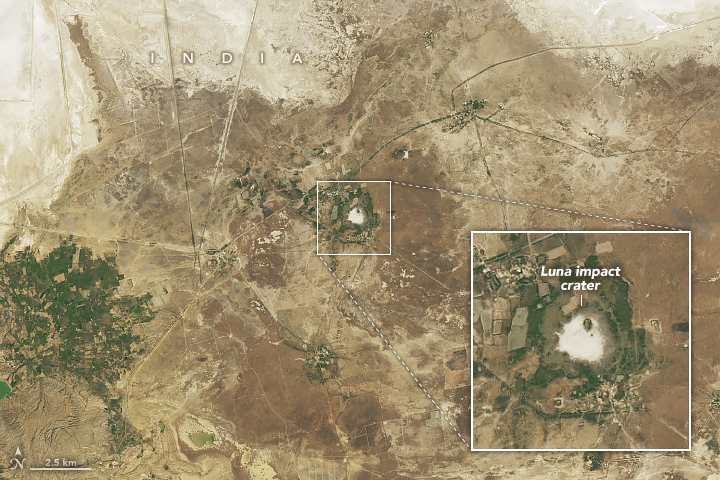
Deciphering India’s Luna Crater
Downloads
- lunacrater_oli_20240224_lrg.jpg (1951x1301, JPEG)
Metadata
- Sensor(s):
- Landsat 8 - OLI
- Data Date: February 24, 2024
- Visualization Date: April 19, 2024
In the Kutch district of northwest India, a vast desert where salt is harvested in colorful rectangular ponds stretches to the Arabian Sea. In a neighboring grassland, a less conspicuous circular feature has attracted curiosity in recent decades. Scientists in India had suspected, but not confirmed, that an object from outer space made this mark on the landscape. Now, a geochemical analysis of the structure has revealed it contains the characteristic signatures of a meteorite impact.
Impact craters on our planet are a relative rarity; fewer than 200 structures from around the world are confirmed in the Earth Impact Database. The number of craters is so modest in part because many of the meteorites that survive the trip through Earth’s atmosphere ultimately splash down into water. Of the meteorites that do fall on land, evidence of their impact may be erased by forces such as wind, water, and plate tectonics.
The footprint of the newly studied Luna impact crater—named for its proximity to a village of the same name—is visible in this image, acquired by the OLI (Operational Land Imager) on the Landsat 8 satellite on February 24, 2024. The crater measures approximately 1.8 kilometers (1.1 miles) across, and its outer rim rises about 6 meters (20 feet) above the crater floor.
The Luna structure is situated in India’s Gujarat state in a grassland called the Banni Plains. The Great Rann of Kutch, an expansive white salt desert, lies just to the north. Parts of these low-lying areas are submerged for much of the year, and the Luna crater often contains water. Researchers took advantage of a dry period in May 2022 to collect samples from throughout the structure.
In the rocks and sediments, scientists detected several minerals that are uncommon in natural settings on Earth. These rare minerals form under the extremely high temperatures and pressures generated when a meteorite hits the ground. The researchers also measured anomalously high concentrations of the rare element iridium, consistent with findings at other impact craters.
Based on the radiocarbon dating of plant remnants contained in silt at the site, the team determined the impact occurred about 6,900 years ago. The crater is near the remains of an ancient Harappan settlement, but it is uncertain whether the impact predates the arrival of humans.
Impact craters appear through our solar system, and they can offer scientists a window into atmospheric processes and subsurface composition of planets and moons beyond our own. For example, a 2021 impact on Mars exposed a layer of water ice, which was imaged by the High-Resolution Imaging Science Experiment (HiRISE camera) aboard NASA’s Mars Reconnaissance Orbiter. This was the closest to the Martian equator that buried water ice had ever been found—a significant discovery for potential crewed missions.
Scientists have also used data from NASA’s Cassini mission to look at the evolution of impact craters on Titan, Saturn’s largest moon. Among other insights, they discerned the different ways that weather shapes Titan’s surface depending on the latitude.
References
- American Museum of Natural History Why study impact craters? Accessed April 19, 2024.
- The Conversation (2018, October 18) How rare minerals form when meteorites slam into Earth. Accessed April 19, 2024.
- NASA Astromaterials Research & Exploration Science What Are Meteorites? Accessed April 19, 2024.
- NASA Earth Observatory (2021, April 17) India’s White Desert. Accessed April 19, 2024.
- Sajinkumar, K.S., et al. (2024) The Luna structure, India: A probable impact crater formed by an iron bolide. Planetary and Space Science, 240, 105826.
- The Telegraph (2023, December 18) In Kutch, imprint of a meteorite crash: 6,900-year-old impact crater is country’s fourth. Accessed April 19, 2024.
NASA Earth Observatory image by Michala Garrison, using Landsat data from the U.S. Geological Survey. Story by Lindsey Doermann.
This image record originally appeared on the Earth Observatory. Click here to view the full, original record.